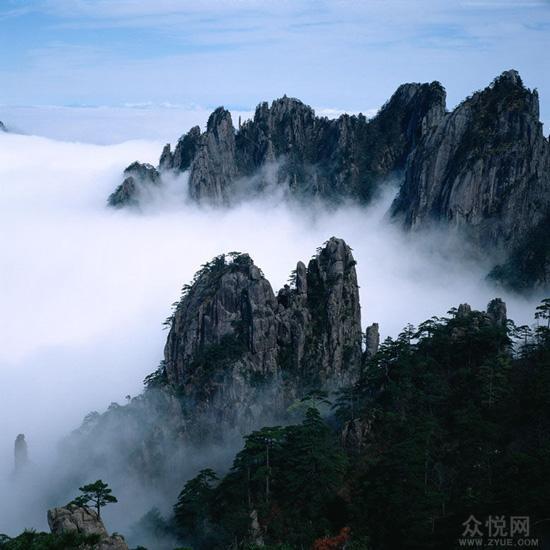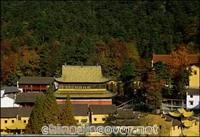
Mount Jiuhua is located in the Qingyang County of the Anhui Province and covers more than 100 square kilometers in area. The Shiwang Mountain, the main peak, is 1342 meters above sea level. Mount Jiuhua is full of waterfalls, streams, exotic-looking boulders, ancient caves, old pines and exuberant bamboo. With the richly variegated landscape, the ancient temples are tucked away amid the dense woods, and the air reverberates with the tolling of the bells at dawn and dusk. With 99 peaks, 16 ridges, 14 overhanging cliffs, 18 gurgling spring, many caves, deep pools rare stones, and waterfalls, the mountain has attracted since ancient times numerous men of letters, who have written poems and articles praising its Southeast China, only the Jiuhua Mountain incorporates both grandeur and wonder. "on poem reads. The mountain is thus famed as the "No.1 Mountain in Southeast China".
The great variety of the beauty of Mount Jiuhua ranges from the hair-raising to the gracefully tranquil. And the scenery keeps varying with the seasonal changes. For instance, the Sea of Bamboo at Minyuan covers 1000 acres (mu), and when the wind blows, the bamboo leaves sibilate with an ear-pleasing cadence while the streams are gurgling and the springs gushing in the background. Standing by a mountain path that threads its way through the Sea of Bamboo is the renowned Phoenix Pine, the so-called "Number One Pine in the Land Under Heaven", which was planted during the Northern and Southern Dynasties, around 1,400 years ago. The tree's verdant foliage, together with its flat, scaly twin trunks form what looks like a green phoenix craning it's neck and flying towards the Heavenly Terrace.
Popular for its spectacular peaks and perilous cliffs, Jiuhuashan is endowed with myriad of springs, streams, waterfalls, grotesque rocks and ancient caves. Covered with luxuriantly green pines and bamboo groves, and gleaming with crystal-clear waters, it offers enchanting scenery. It's also famous for the grand scale of temples and nunneries, which are unique in style and magnificent in architecture. At present, still exist 79 well-preserved temples, over 1500 Buddha statues and more than 1300 pieces of cultural relics like Buddhist scriptures, musical instruments etc. Huacheng Temple lies in mid Jiuhuashan, it's enclosed by the mountains, with Furong Peak to the south, Shenguang Ridge to the west, White Clouds Mountain to the north, and cliffs to the east. The Temple, consisting of four rows of houses, was built on the mountainside.
Mount Jiuhua was originally known as Jiuzi (Nine-Peak) Mountain. But ever since Li Bai, the celebrated poet in the Tang Dynasty wrote of the mountain:  "Sailing down the Jiujiang River the other day, I saw the Jiuhua Peaks in the distance. Looking like a heavenly river hanging in heaven, Its green water embroidering cottonrose hibiscuses.", the mountain was renamed as Mount Jiuhua.The 10 major sights of Jiuhua are as follows: 1. The mountain scenery by the Five Streams 2. The waterfall at Taoyan 3. The moon mirrored in the Shutan Pool 4. The serene form of the East Cliff 5. The snow mantle over the Flat Terrace 6. Evening Bell Tolls at Huacheng 7. The Sea of Clouds around the Lotus Peak 8.The Singing Stream at Jiuzi 9. Cellestial Presence at the Heavenly Pillar 10. Sunrise at the Heavenly Terrace.
"Sailing down the Jiujiang River the other day, I saw the Jiuhua Peaks in the distance. Looking like a heavenly river hanging in heaven, Its green water embroidering cottonrose hibiscuses.", the mountain was renamed as Mount Jiuhua.The 10 major sights of Jiuhua are as follows: 1. The mountain scenery by the Five Streams 2. The waterfall at Taoyan 3. The moon mirrored in the Shutan Pool 4. The serene form of the East Cliff 5. The snow mantle over the Flat Terrace 6. Evening Bell Tolls at Huacheng 7. The Sea of Clouds around the Lotus Peak 8.The Singing Stream at Jiuzi 9. Cellestial Presence at the Heavenly Pillar 10. Sunrise at the Heavenly Terrace.
At the foot of the mountain is the vast expansion of fields. Ancient cypresses cover the mountains and hills with various shapes of peaks, and waterfalls and springs. In the early 5th century, Buddhism was introduced there. During the reign of Emperor Kaiyuan of the Tang Dynasty, Jin Qiaojue from South Korea came to China and stayed for 70 years. He died in 794 m Mt. Jiuhua.
Mount Jiuhua consists of ninety-nine peaks, among the most magnificent being Heavenly Terrace (Tiantai), Lotus Flower (Lianhua), Sky Pillar (Tianzhu), and Ten Kings (Shiwang).
The area around the mountain is secluded -- a quiet landscape of streams, cascades, crags, caves, pines, and bamboos. Tang Dynasty and culminated in the Ming and Qing dynasties, when with over three hundred temples and monasteries enveloped in coiling incense smoke, Mount Jiuhua became known as the "land of Buddhas and incense." At present 78 temples remain, including Huacheng, Flawless Monk, Hujiu, and Baisui temples, which house thousands of statues and relics such as Buddhist sutras and jade seals.
The skeleton of Monk Wu Xia of the Ming Dynasty in a sitting position is well-preserved on the mountain. The monk lived in a cave and subsisted on wild fruits and spring water until his death at the age of 126.
